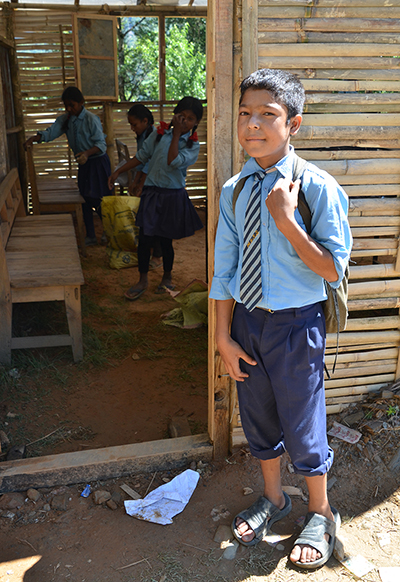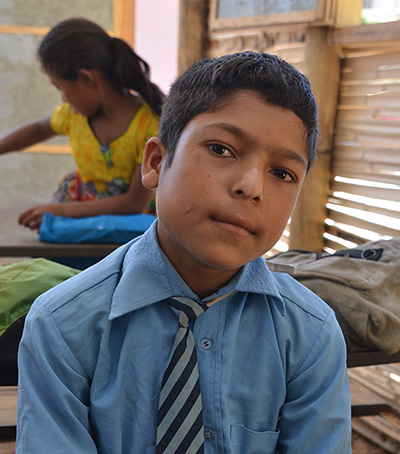This story was collected in mid-June 2015, two weeks after schools affected by the earthquakes re-opened in Nepal.
Dipesh Nepali's life was literally shaken on April 25, 2015. The 12-year old boy was on a tree eating fruits with friends when the magnitude 7.9 earthquake shook his country.
Dipesh lives in Sindhupalchowk, one of the districts most heavily affected by the earthquake. The mountainous district borders Tibet, and although close from the capital Kathmandu, it is one of the poorest districts in the country.
Until that day, Dipesh did not know what earthquakes were. Although he had heard of them, he had never experienced one. That morning, as usual, he was on the tree relaxing with five of his friends, but just a few moments later, they were thrown violently to the ground.

Dipesh in front of his temporary classroom.
Startled, they ran to the only blacktopped road in the village, where other villagers had gathered. There, Dipesh found his mother, who had been washing clothes at home when the earth shook, along with his younger brother and sister. Later, when they went back home, they found their stone house completely destroyed.
That night, Dipesh and his family stayed outside and didn't eat. The following day, they went back to their destroyed house and found clothes to change. Dipesh was also able to retrieve his notebooks.
Community members put up a shelter with a tarpaulin where villagers could stay. After around 10 days in the shelter, Dipesh's family built a temporary home, with the tin roof from their original home. They still live there. Dipesh's parents are farmers, and not well-off, so they have little means to rebuild their home.
As the school was closed, Dipesh spent his time with friends, playing, and drawing pictures. But he could not sleep well right after the earthquake, waking up several times at night and worrying for his btorher. Thankfully, now he sleeps better.
Dipesh's school, Shree Mahendrodaya Higher Secondary School, reopened its doors on May 31, as did the other closed schools in earthquake-affected districts as per the government directive. Dipesh's school has around 500 students, from pre-primary all the way up to grade 12. Of the 28 classrooms, 12 were destroyed, and 8 were partly destroyed. The school director and the community members are proactive: one week after the earthquake, without waiting for government support, they built temporary classrooms with bamboo, wood and tarpaulin.
During the summer, the temperature can reach as high as 40 degrees Celsius. Under the tarpaulin roof, the temporary classrooms become very hot, but Dipesh does not complain. "I am just happy that school re-started. I can spend time with friends and learn Nepali, my favorite subject".

Dipesh is happy to be back in school.
"I want to be a doctor when I grow up", Dipesh says. "I want to check up on my community members' health and be able to help".
In the meanwhile, it will take a long time for Dipesh and many other Nepali children to be able to study in their "normal" classrooms.
The Ministry and Department of Education, with development partners, were quick to react and conduct a rapid assessment of the schools, giving green stickers for buildings that were safe and red stickers for those unsafe.
Temporary Learning Centers (temporary classroom structures) were set up, pedagogical materials provided, and teachers received trainings to give psychosocial support to affected students.
However, tremendous challenges lie ahead for the education sector of Nepal, with nearly 36,000 classrooms destroyed and another 16,000 requiring repair (according to the Nepal Education Cluster Earthquake Response Strategy May-Sep 2015).
An estimated 1.1 million children were unable to return to their normal classrooms when classes resumed on May 31. Recently, more detailed assessments have been carried out in the affected districts, and the government is planning to "build back better", to make sure schools are resilient to future disasters.
This means that the number of unsafe classrooms requiring repair or reconstruction is going up, since even if a classroom appears intact, it may be considered unsafe if it is built with materials prone to earthquake damage like stone-in-mud. According to a detailed structural assessment completed recently in Sindhupalchowk District, 89% of classrooms (4,620 in total) are considered unsafe.
Check the Nepal Education Cluster website, containing quality and up-to-date materials on the Nepal's earthquake response for the education sector.








